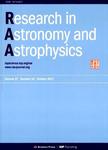Statistical analysis of dynamic fibrils observed from NST/BBSO observations
Statistical analysis of dynamic fibrils observed from NST/BBSO observations作者机构:Key Laboratory of Solar Activity National Astronomical Observatories Chinese Academy of Sciences Beijing 100012 China University of Chinese Academy of Sciences Beijing 100049 China State Key Laboratory for Space Weather Center for Space Science and Applied Research Chinese Academy of Sciences Beijing 100190 China California State University Northridge CA 91330 USA
出 版 物:《Research in Astronomy and Astrophysics》 (天文和天体物理学研究(英文版))
年 卷 期:2018年第18卷第2期
页 面:43-52页
核心收录:
学科分类:0709[理学-地质学] 07[理学] 0708[理学-地球物理学] 070401[理学-天体物理] 0704[理学-天文学] 0825[工学-航空宇航科学与技术]
基 金:supported by the National Natural Science Foundation of China(Grant Nos.11427901,11773038,11373040,11373044,11273034,11303048,11178005and 11711530206) supported partly by the State Key Laboratory for Space Weather,Center for Space Science and Applied Research,Chinese Academy of Sciences supported by NJIT US NSFAGS-1250818 NASA NNX13AG14G financial support from the CAS-TWAS Presidents PhD fellowship–2014
主 题:Sun: sunspots oscillation Sun: magnetic fields Sun: chromosphere
摘 要:We present the results obtained from the analysis of dynamic fibrils in NOAA active region (AR) 12132, using high resolution Ha observations from the New Solar Telescope operating at Big Bear Solar Observatory. The dynamic fibrils are seen to be moving up and down, and most of these dynamic fibrils are periodic and have a jet-like appearance. We found from our observations that the fibrils follow almost perfect parabolic paths in many cases. A statistical analysis on the properties of the parabolic paths showing an analysis on deceleration, maximum velocity, duration and kinetic energy of these fibrils is presented here. We found the average maximum velocity to be around 15 km s-1 and mean deceleration to be around 100 m s-2. The observed deceleration appears to be a fraction of gravity of the Sun and is not compatible with the path of ballistic motion due to gravity of the Sun. We found a positive correlation between deceleration and maximum velocity. This correlation is consistent with simulations done earlier on magnetoacoustic shock waves propagating upward.



